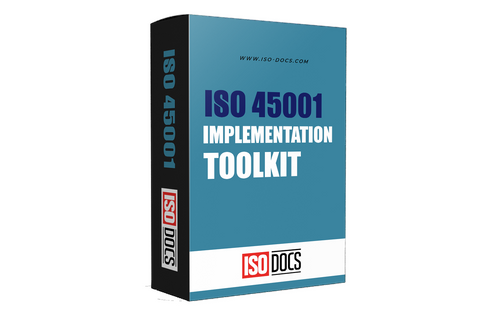ISO 45001 Implementation Checklist Template
Introduction
Implementing ISO 45001 is a crucial step for organizations aiming to improve their occupational health and safety management systems. This standard provides a framework for managing workplace safety and ensuring the well-being of employees. In this guide, we will explore what ISO 45001 is, its benefits, and the implementation process to help you navigate your journey towards certification.

What Is ISO 45001 And Why Is It Important?
The main aim of ISO 45001 is to ensure Safety and health, outlining the requirements for an occupational health and safety standard. It ensures a safe and healthy workplace by minimising risk and preventing work-related injuries and illnesses. The importance of ISO 45001 lies in its ability to create a safe work culture within organizations, ensuring safety is prioritized at all levels. By adopting these standards, companies can demonstrate their commitment to employee welfare and compliance with legal obligations.
Benefits Of ISO 45001 Certification
- Helps in reducing workplace accidents and incidents, leading to the safest environment for employees.
- Improves employee morale and productivity, as workers feel valued, protected, and safe.
- Enhances an organization's reputation, making it more attractive to clients and partners who prioritize safety.
- Leads to cost savings by reducing insurance premiums and minimizing the financial impact of workplace accidents.
Overview Of The ISO 45001 Implementation Process
The implementation process for Iso 45001 involves several key steps. Initially, organizations should conduct a gap analysis to assess their current OHS management practices against the standards requirements.
Following this, a risk assessment checklist should be developed to identify potential hazards and evaluate risks. Next, the organization must set objectives, establish OHS policy, and develop an action plan to address identified risks. Training and communication are the most essential components to ensure all employees understand their roles in maintaining a safe workplace.
Finally, organizations should conduct regular audits and reviews to ensure continuous improvement and compliance with standards.
Step-By-Step ISO 45001 Implementation Guide
Implementing ISO 45001 is a major step in any organization aiming to improve occupational health and safety management. This guide outlines a structured approach to ensure a successful implementation process, helping organizations meet the requirements of the ISO 45001 standards.
Step 1: Gap Analysis And Planning
The first step is conducting a gap analysis. This analysis helps us identify the current state of your occupational health and safety management system compared to the ISO 45001 requirements. By identifying the needs to improve, organizations can develop a comprehensive plan that outlines the necessary actions, resources, and timelines for achieving compliance.
Step 2: Policy Development And Implementation
Once the gap analysis is done, the next step is to develop a health and safety policy that aligns with the organization’s objectives. This policy should be adhered to for continuous improvement and compliance with legal requirements. After the policy is established, it must be communicated to all employees and integrated into the organization's culture to ensure everyone in the organization understands their roles and responsibilities.
Step 3: Risk Assessment And Control
Risk assessment is the most important component of the ISO 45001 implementation process. The organization should conduct an assessment to identify potential hazards and evaluate the risks associated with them. This step involves implementing control measures to mitigate identified risks, ensuring a safer workplace environment for employees. A well-documented risk assessment checklist can aid in this process, providing a clear framework for identifying and addressing risks.
Step 4: Training And Communication
Effective training and communication are essential for the successful implementation of ISO 45001. Employees should receive training on the new policies, procedures, and risk management practices. Regular communication with the employees ensures a culture of safety and encourages employee engagement in the implementation process.
Step 5: Internal Audits And Management Review
The final step involves conducting an internal audit to assess the effectiveness of the implementation system. These audits help identify areas for improvement and ensure compliance with ISO 45001 standards. Following the audit, management reviews should be conducted to evaluate the overall performance of the occupational health and safety management system and make necessary adjustments to enhance its effectiveness.

Real-World Case Studies: Successful ISO 45001 Implementations
Case Study 1: A Manufacturing Company's Experience
A leading manufacturing company faced challenges related to workplace safety and employee well-being. After adopting the ISO 45001 framework, they conducted a thorough risk assessment, identifying potential hazards and implementing control measures. The company established a safety committee that included employees from various departments, fostering a culture of safety and collaboration. As a result, they reported a 30% reduction in workplace incidents within the first year of implementation. This case underscores the importance of employee involvement and continuous monitoring in maintaining a safe work environment.
Case Study 2: A Healthcare Provider's Journey
A healthcare provider recognized the need for a structured approach to occupational health and safety. By implementing ISO 45001, they developed comprehensive training programs for staff, focusing on risk management and emergency preparedness. The organization also integrated safety protocols into its daily operations, ensuring that all employees were aware of their responsibilities. Following the implementation, the healthcare provider noted improved staff morale and a decrease in workplace accidents, demonstrating the positive impact of a safety management system in high-risk environments.
Key Takeaways And Lessons Learned
- Engaging employees at all levels is crucial for fostering a safety culture.
- Regular training and communication about safety protocols can significantly reduce workplace incidents.
- Continuous evaluation and improvement of safety practices are essential for maintaining compliance and ensuring employee well-being.
By learning from these experiences, organizations can better navigate their own ISO 45001 implementation journeys.
Conclusion/Key Takeaway
The benefits of implementing ISO 45001 are numerous. Organizations can expect improved workplace safety, reduced incidents of occupational injuries, and enhanced employee morale. Furthermore, achieving ISO 45001 certification can lead to increased trust from clients and stakeholders, as it demonstrates a commitment to maintaining high safety standards.


